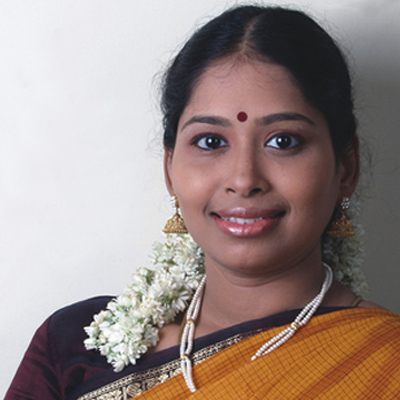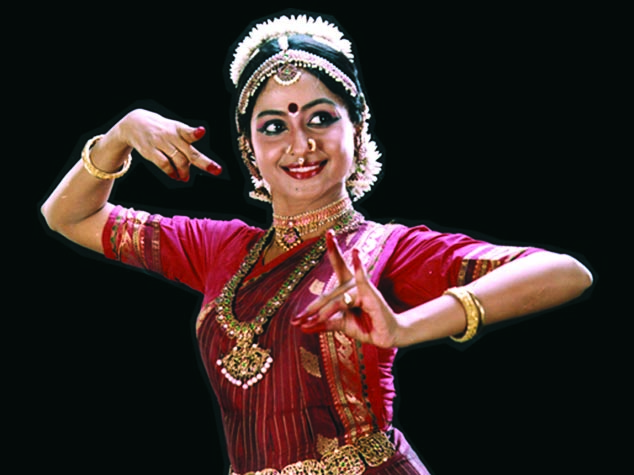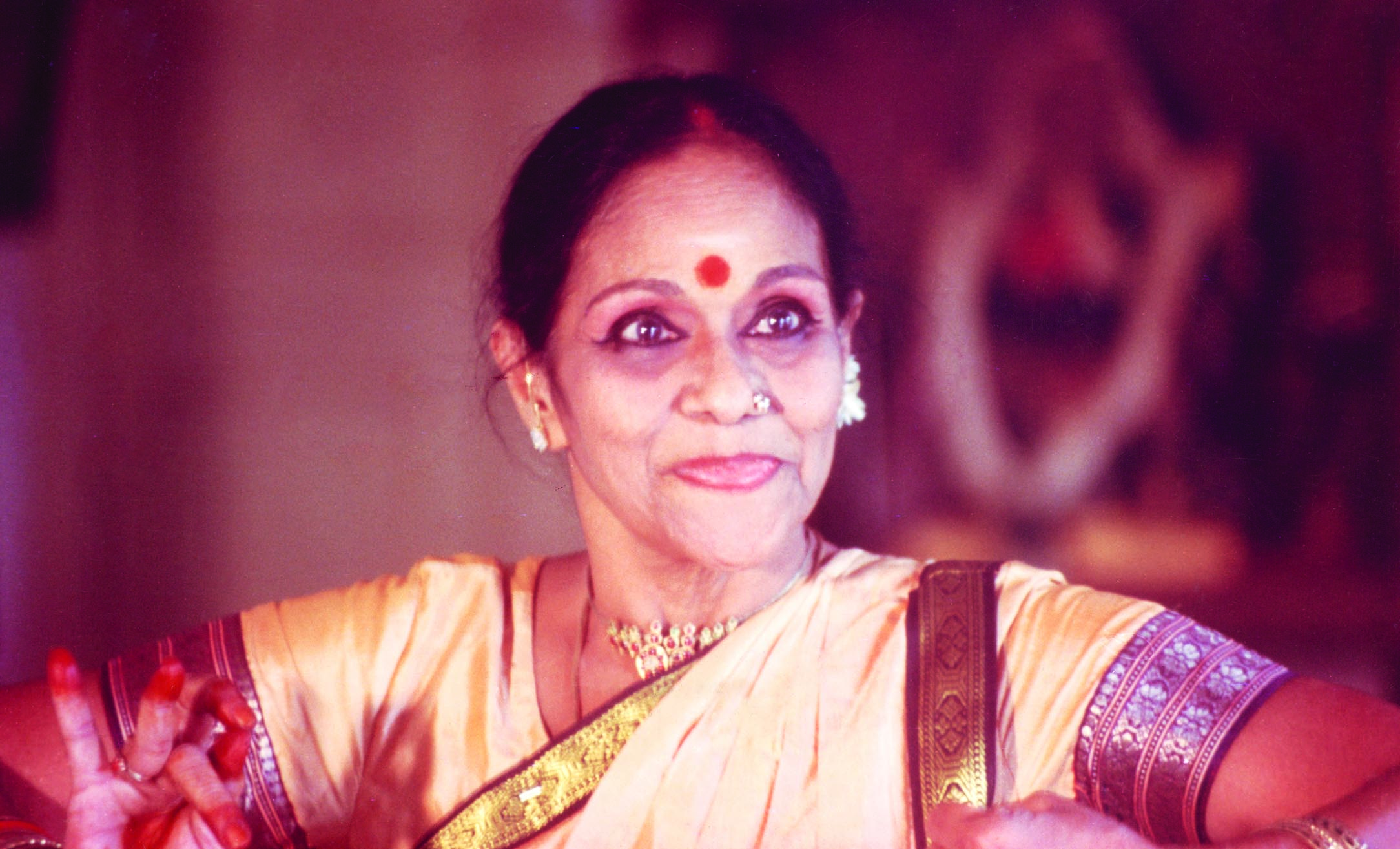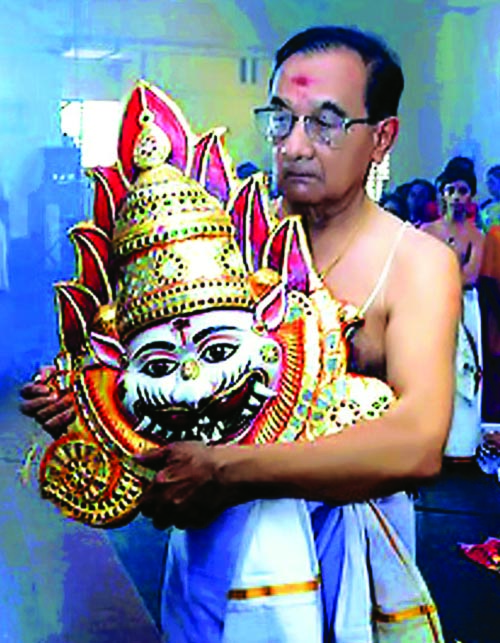Even before her first formal lesson, a varnam, the young girl had already picked up the corpus of songs that the entire household knew by heart, like Santi nilava vendum, Eppadi paadinaro, Mamava Pattabhirama. The omnipresent melodies flowed into her utterly unconsciously. Nithyasree Mahadevan was born on 25 August 1973 to I. Sivakumar and Lalitha Sivakumar. A more pedigreed legacy would be hard to find, with her paternal grandmother being the eldest of the female Carnatic triumvirate—D.K. Pattammal, and maternal grandfather being mridangam virtuoso Palghat Mani Iyer. Nithyasree, interestingly, was born in Tiruvaiyaru since Palghat Mani Iyer, at the time of her birth, lived on Pushya Mandapam Street there—the very street Tyagaraja had lived in. Nithyasree explains that Palghat Mani Iyer moved often, living in some 60-70 residences in his lifetime! She grew up almost entirely in Chennai, with her parents, her elder sister Gayathri, and her grandparents, Iswara Iyer and Pattammal, living right across from them. She studied in Alpha School until 7th Grade and then completed the rest of her schooling at the Ramakrishna Mission’s Sarada Vidyalaya. She did her B.Com from SIET College, and also the first year of her M.Com, musical demands preventing its completion.
Deep faith in the guru and the divine CHITRA MAHESH “When you truly dance, you dance yourself free. When you walk in the mountains or swim in the sea, again you set yourself free.”—Julia Woodman. Not too long ago, I came across a striking artist whose stance in her varnam made me understand that her dance is for eternity. She brought out the perfect geometry of her body angle and sheer poetry to her dance. Time has passed, and many things have happened to make a dent in the dancing life of many, but when integrity and memories remain fresh, you only remember that you found her fascinating as a dancer and a teacher par excellence. Urmila Sathyanarayanan is not someone who needs any introduction. Her quiet but confident standing in the world of dance is unquestionable for the way she has carved a niche for herself and the way she has handled herself as well as her students who truly do her proud. She faces these times and challenges with the same equanimity that she had dealt with when life was the way it was. It takes a deep probing to talk about her inner feelings and thoughts about her dance and all that it means to her. “I was three years old when I joined Saraswathi Gana Nilayam,” she begins. Urmila was born on 8 January 1966. When she turned four, she participated in her grandfather’s 60th birthday along with the group of Saraswathi Gana Nilayam, where bits and pieces of the sabdam, Sami ninna chala namiti were performed as also the role of kutti Krishna in the Dasavataram. This was her involvement with dance until she was six years old. “I used to go in a hand-drawn rickshaw to my teacher, Shakuntala, who was perhaps the earliest influence when it comes to dancing.” She was then taken to guru K.N. Dhandayudhapani Pillai or ‘Master’, who accepted her much to her mother’s gratitude – “My mom was very grateful, and I would spend a lot of time in my Vadhyar’s house. My father, a doctor, would drop me on the way to the clinic and would pick me up later after I was done.”
The lingering aroma of an age is gone ?? LEELA VENKATARAMAN Madras Kadiravelu Saroja, or M.K. Saroja as she was known, born on 13 June 1922, departed from this world as unobtrusively as she had lived. With all her attainments, she always called herself “the guru’s student” rather than a dancer in her own right. This innate humility was a part of her, notwithstanding laurels like the Kalaimamani, the Central Sangeet Natak Akademi award in 1996, the Padma Shri in 2011, and Sruti’s E. Krishna Iyer Medal won in 2000. As a teacher, Saroja was also a recognised Visiting Fellow at Rabindra Bharati University under the then Calcutta University Grants Scheme. Saroja’s kind of self-abnegation is a rarity in today’s world, where people in most walks of life are wont to lay claim to greatness, rarely substantiated by the person’s innate abilities or achievements. And, it was not as if Saroja had been raised like a hothouse plant in specially sheltered surroundings either. Born to an affluent Mudaliar couple Kadiravelu of Kumbakonam and wife Rajamma, who hailed from Kanchipuram, she was a bare six-year-old when she, along with her older sister Selvamani, came under the training of Kattumannarkoil guru Muthukumara Pillai (who was always Thatha for her), when he was invited to stay in their house by her ‘chinna athai’ (father’s younger sister), while the guru was engaged in teaching kolattam and other art disciplines in the local P. Sambamurthy School. The love for art and dance flowed from Saroja’s grandmother Meenakshiammal. Selvamani, considered too old to dance after her arangetram in Soundarya Mahal, was urged by the guru to pursue the dance connect, by becoming one of the first female concert conductors providing
“All art emulates the condition of rituals. That is what it comes from, and to that, it must always return for nourishment,”—T.S. Eliot. This thought must have been the basis of the 82nd year of Bhagavata Mela Nataka Mahotsav held from 19 to 27 May 2022. Presented by the late S. Natarajan’s Bhagavata Mela Natya Nataka Sangam, Melattur, now under the diligent direction of ‘Kalaimamani’ S. Kumar, who is the grandson of V. Ganesa Iyer of Melattur who revived this art form in 1938. Though, there is a lot written and debated about the background and foreground of the traditional art form that enthralls class and mass alike, we are yet to get a candid peek into the story of the art that seemed to have been endangered, since the demise of its legendary torchbearer S. Natarajan—the elder brother of S. Kumar. The belief and deep acknowledgement that art is greater than the artist led to the possible new collaboration from the old womb—a promise to Kumar’s grandfather and an oath before the presiding deity of the art – Sri Nrusimha. Kumar was not ready to let go, albeit with a mind full of turbulence, yet with the calm of decidedness. Conducting the 82nd Melattur Bhagavata Mela natakam was a huge challenge that lay before the artist. Not just because it had to be his directorial debut and the acceptance and outcome would remain shrouded in ambiguity till the very end. There was so much unprecedented challenge that in his words, the outcome and the success was the doing of none other than Lord Nrusimha himself.
CONTENTS Vol. 29
Issue 9 September 2022
6 News & notes
10 Birthday calendar
12 Nithyasree Mahadevan
19 M.K. Saroja
30 Urmila Sathyanarayanan
38 Collaborations v Aditya Prakash
and Carnatic fusion
42 Perspective
v The 82nd
Melattur Bhagavatha Mela natakam
45 Bookshelf
46 From the Editor
Front
Cover: M.K. Saroja (Photo courtesy: MKDC@IGNCA)
Nithyasree Mahadevan
Urmila Sathyanarayanan (Photo courtesy: Samudri Archives)
No. 456






